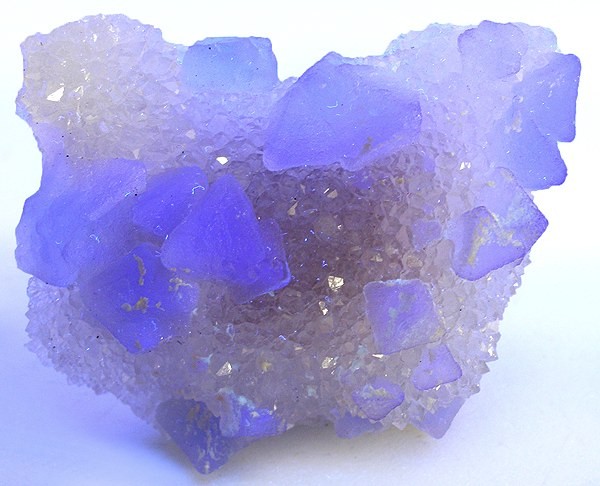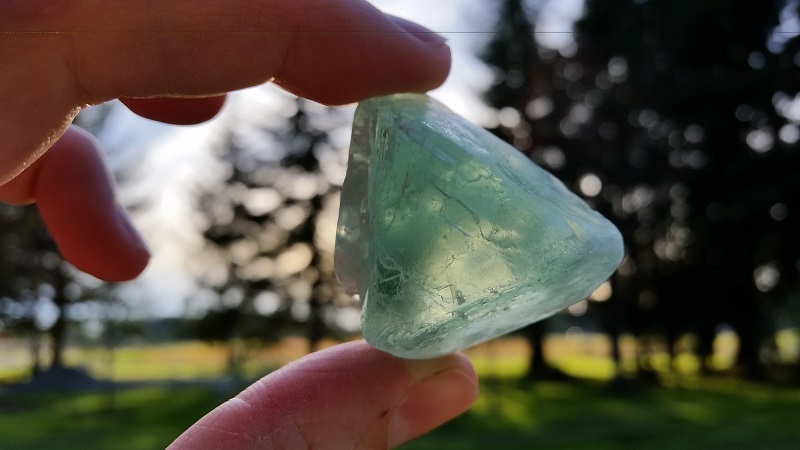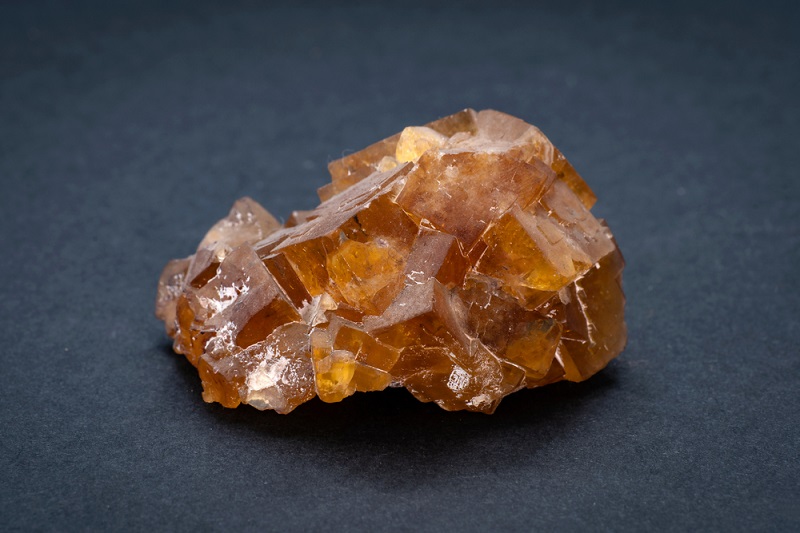Fluorite is a common mineral for collectors, whether it’s just a few tumbled stones or large crystalline specimens that dominate a shelf. The wide range of colors, and ease of working, make it a long-lasting favorite for many of those who collect mineral specimens.
There’s more to this mineral than meets the eye, however, so let’s dive in and I’ll teach you some interesting facts about fluorite.
1. It Glows Under UV Light

Let’s start with the basics: Fluorite glows underneath ultraviolet light. The glow is called, naturally, fluorescence, and the term was named after the property was noted in the mineral.
Virtually all Fluorite will glow blue underneath a UV light, but the patterns are often still visible under UV light. This is especially true for banded specimens, the bands remain visible when the stone is illuminated and glowing.
Some will glow with different colors due to different impurities causing the fluorescence.
The mechanism is thought to be the inclusion of certain elements, such as yttrium, contained in the matrix of the crystals. Like colored quartz, these trace elements are actually included in the crystal matrix as a substitute for calcium in the stone’s structure.
While this is one of the most commonly known special properties of fluorite, it’s still impressive to see in person. If you have a sample and haven’t taken a look, picking up a small UV light should be a priority!
2. Pure Fluorite is Colorless
Fluorite is known for its brilliant colors. The majority of collected specimens seem to be purple, or purple and green, but they’re actually not quite the pure mineral. Instead, they’re colored by different impurities that cause the stone to absorb and reflect different spectrums of light.
Fluorite is actually a colorless, clear mineral when it lacks these impurities. It still fluoresces underneath a black light, but it often appears clear or milky white.
The formula for pure fluorite is actually pretty simple: CaF2. It’s hard to believe that it’s considered one of the most colorful stones around.
The exact reason for the different colors varies. It can be impurities trapped in the solution or the actual crystal matrix, irradiation and heat also have an effect on the colors of the stone. You can find fluorite in just about every major color if you look hard enough.
The fact remains that pure fluorite is actually colorless, regardless of the rainbow colors available to the collector!
3. Some Fluorite Changes Colors in Different Light

Some gemstones will change color depending on the lighting. Usually, the biggest differences are between natural sunlight and incandescent light which is used in homes. CFL and LED lighting can also change the colors of the stone, depending on the exact wavelength.
Color-changing fluorite is available, and it’s often cut into facets. While they’re still too soft for most jewelry, they have the curious property of appearing blue or purple depending on the lighting that’s hitting them at that moment.
The mechanism has to do with how our lights perceive color. Essentially, the different wavelengths of light sources will change the reflected colors from the stone, which is how we perceive them visually.
The end result? A stone that costs a fraction of the high costs of alexandrite but exhibits a rather dramatic color change. Not all fluorite has this property, but it’s an impressive sight in person.
4. Fluorite is an Important Industrial Mineral
In addition to being an excellent lapidary material and its use in jewelry, the majority of fluorite is actually used as an industrial mineral.
It’s very important for both steel and aluminum production, where the mineral is ground up and used as a flux. It’s also used as a flux in other materials that need protection from oxidation, including glass and enamel.
Fluorite’s simple chemical structure also makes it important for commercial and industrial-scale chemistry. It’s used to produce hydrofluoric acid, which is the basis for the majority of chemicals that contain fluorine in chemical engineering applications.
Fluorite, in addition to being pretty, is actually one of the key mineral elements that help our technology function. It’s hard to overstate its importance in our supply chain, where fluorite ends up in the supply chain for everything from dental supplements to steel.
5. Fluorite Naturally Forms Cubic Crystals

One of the neater properties of fluorite is its distinctive crystalline structure. It forms with a cubic system, that can be more or less apparent depending on exactly how the cube was formed in the ground.
The best samples are often almost perfect cubes, sometimes missing small cubic portions along the edges. These samples can command a high price compared to many other types of fluorite, especially if they have deep coloration as well.
These crystals are often twinned, with them growing into each other to create interesting shapes.
While not a rare crystal system, fluorite is one of the better examples out there. It also makes it quite obvious at first glance. The relative rarity of right angles in nature makes fluorite stand out on its own.
6. Fluorite is Used to Make Lenses
Fluorite actually bends light less than standard glass, making it an ideal component of lenses. They’ve been used for a few hundred years, but they were mostly restricted to small applications like microscopes.
That’s simply due to the fact that chemically pure fluorite samples are rare and often quite small. Instead, the lens industry uses lab-grown fluorite to create larger lenses than you’d be able to with just the natural crystals.
These lenses reduce the distortion of color from the lens due to fluorite’s optical properties. They’re also even harder to produce than glass or crystal lenses despite the stone’s softness. While soft, fluorite is also quite fragile and you can shatter the entire piece if you use normal methods.
Instead, lens makers have developed their own sub-industry of growing the crystals and shaping them in a different way than the usual methods. These lenses are very expensive, due to the time and expense involved in growing the crystals and grinding them, but they offer superior optical properties.
It never fails to amaze me just how ubiquitous some minerals are, but fluorite certainly takes the cake with its versatility of use in industry, art, and even technology!
- Online rock and mineral club for collectors of all levels!
- Find community with like-minded rock and mineral enthusiasts.
- Monthly Giveaways!
- Free Access to Entire Digital Library of Products (annual memberships)


